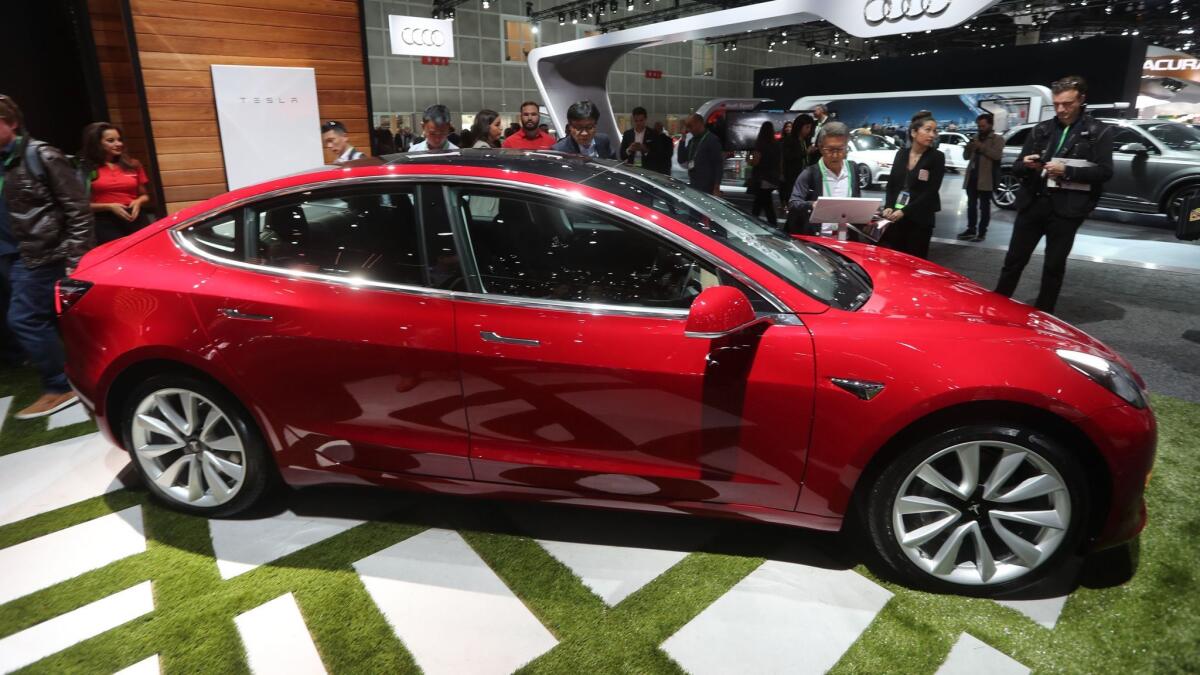Tesla seems to be emerging from Model 3 ‘production hell,’ but how quickly?

- Share via
Tesla Inc. may have delivered about four times more Model 3 sedans last quarter than in the prior three months, or boosted deliveries by a factor of 27, depending on which analyst you ask.
Either end of that range would be a vast improvement over last year’s third quarter — when “production hell” led the company to deliver just 220 of the cars — and would fall far short of the target pace Tesla announced earlier in the year.
The broad range of estimates reflects how little the electric-car maker has disclosed about the progress it has made speeding up production of its sedan that starts at $35,000. Model 3 deliveries might have climbed to about 2,917 vehicles, the average estimate of nine analysts surveyed by Bloomberg News.
Mass producing the Model 3 is crucial to Chief Executive Elon Musk’s goal to transition Tesla from a niche player into a more mainstream automaker. But the roll-out of the car has been marred by manufacturing issues at Tesla’s Fremont, Calif., assembly plant and at its battery factory in Nevada. Tesla delayed by a quarter its target to produce 5,000 Model 3s per week, and the company hasn’t said whether the 10,000-unit weekly pace it was planning for sometime this year is still possible.
“People are past the shine of saying, ‘OK, you guys are a great design and marketing house,’” said Joe Fath, a fund manager at T. Rowe Price, one of Tesla’s largest shareholders. “Now they want to see the manufacturing execution come through.”
Focal point
There are signs deliveries have picked up, with the first wave of nonemployees posting about their new cars on message boards and social media. Still, the automaker has kept details on Model 3 shipments close to the vest, leaving Wall Street largely in the dark about what fourth-quarter production figures will look like.
As a result, analyst estimates are all over the map. On Tuesday, Jeffrey Osborne of Cowen & Co. forecast deliveries of 2,250 Model 3 sedans in the final quarter of 2017, down from his earlier estimate of 9,100. Colin Rusch of Oppenheimer estimates only 800. Manufacturing bottlenecks limited third-quarter deliveries to just 220 cars; in July, Musk said the company was “deep in production hell.”
Gene Munster, cofounder of research-driven venture capital firm Loup Ventures, estimates about 2,500 Model 3 deliveries for the quarter but said he remains bullish on the stock in the long term.
Staying upbeat
“The reason we remain upbeat on the Tesla story despite the prolonged Model 3 production problems is because EV and autonomy are the future,” Loup wrote in a Dec. 28 research note. “Tesla is fighting to gain production scale to create that future.”
Investors have been largely forgiving of Tesla’s production setbacks thus far, with Tesla’s market capitalization vaulting past Ford Motor Co.’s in 2017. The shares climbed 46% last year.
Although much attention will be on the Model 3, this week Tesla also is expected to release sales and production figures for its flagship Model S sedan and Model X sport utility vehicle. The company delivered 76,230 vehicles in 2016 and has said it expects to deliver about 100,000 Model S and X vehicles in 2017.
Hull writes for Bloomberg.
More to Read
Inside the business of entertainment
The Wide Shot brings you news, analysis and insights on everything from streaming wars to production — and what it all means for the future.
You may occasionally receive promotional content from the Los Angeles Times.










